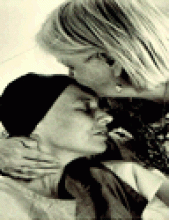As part of my pre-shift prep I search for my stethoscope and wonder: Will it happen today? I exchange my sneakers for scrub shoes and think: Will it happen today? I caress my palm pilot, confirming it's there, and have the same thought again. And again as I pull laminated flowsheets from my pocket, reassuring myself that they're there, too.
Figure. Photo by: Anson Liaw
I'm speaking here of the pediatric code.
I'm not a code virgin. I've led dozens on adults and been part of a handful on kids. I've intubated infants, toddlers, prepubertals and adolescents. I have more than an understanding of PALS and NRP protocols — in fact, I can recite exactly how and when I am supposed to save every age group with drug, shock and tube.
I write this not out of arrogance, for I've memorized this information out of fear. I review the contents of the flowsheets before every shift, thinking this ritual will give me some kind of control over the possibility that a child will die in the department today. By knowing exactly what to do, I hope that I'll be a good leader, that I'll inspire confidence in staff, that I won't fumble out of ignorance and in that fumbling increase the fear that I will inevitably feel.
I think Will it happen today? because I know that, sooner or later, it will. As it did, last week. Several hours into the shift, my fear was gone, replaced with worry about the waiting room backlog. I remember considering breaking for lunch when static broke on the ambulance line and an attendant said, Two-year-old, grey, no respirations or heart sounds, ETA two minutes.
Those words aroused my greatest fear as a doctor; to unfreeze, I touched my laminated placards, which was no help. I saw people looking at me, expecting me to do something. And it was their expectation that put me into action. I called for extra nurses, pulled down the age-appropriate intubation kit, and taped the Breslow chart to the stretcher.
The child was delivered to the bay by the paramedic, cradled in his arms and set down on the stretcher so quickly and so gently that the paramedic seemed like a lithe quarterback taking in his own touchdown. The child's father followed with a heavy step. After telling us in a low voice that no one knew how long the child hadn't been breathing, the paramedic slowly stood back. The father stood sobbing, watching us work. The paramedic then took him to an alcove away from the fray.
There is a certain omniscience in such situations. Inserting the laryngoscope, I couldn't help but sweep the scene — the team intent on their tasks, the paramedic's hand on the father's back. And I saw past that moment to another part of my fear, the fear of telling a parent of my failure, as I probed this cool child and rocked the jaw open — all my strength and the kid was too stiff; I couldn't see where to put the endotracheal tube ...
That night, I looked in textbooks for the reason why I couldn't get the jaw to open properly, discovering: the masseter muscle is one of the first to clench in death.
I walked toward where the father and paramedic had gone, a comfortable room where families can relax. I looked at the father and told him that his child was dead. I paused after that, stood back, and waited.
As I stepped back, I understood where most of my fear was coming from. I have a daughter who's two, and I'm sure that every minute I spend memorizing protocols and flow diagrams is a voodoo minute warding off exactly the kind of situation this young father was in.
I'm not just afraid that it will happen; I'm afraid that it will happen to me.
— Dr. Ursus









